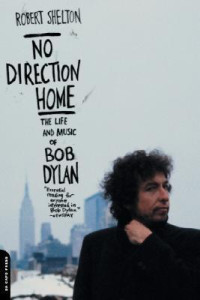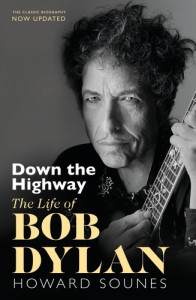 Where can I begin the story? I’d need a film camera’s flashing chain of images: Dylan at London’s Wembley Stadium in 1984 as 100,000 strangers sing his words…or Chicago, starting Tour ’74 to a thundering ovation…at London’s Albert Hall and the Olympia in Paris in May 1966, Dylan resisting hostility to his new music…or playing to Blackbushe in 1978, at Britain’s largest-ever rock-concert audience…maybe back at Folk City in 1961, Dylan in his black Huck Finn corduroy cap, galvanizing us with intensity and gamesmanship…Dylan sitting at Jack Kerouac’s grave in 1975, improvising a tribute to one of the writers who opened new roads to him…or his turbaned head on national TV in 1976, looking oppressed and singing oppression. Sometimes his whole life seems like a performance. (Robert Shelton, No Direction Home, p. 13)
Where can I begin the story? I’d need a film camera’s flashing chain of images: Dylan at London’s Wembley Stadium in 1984 as 100,000 strangers sing his words…or Chicago, starting Tour ’74 to a thundering ovation…at London’s Albert Hall and the Olympia in Paris in May 1966, Dylan resisting hostility to his new music…or playing to Blackbushe in 1978, at Britain’s largest-ever rock-concert audience…maybe back at Folk City in 1961, Dylan in his black Huck Finn corduroy cap, galvanizing us with intensity and gamesmanship…Dylan sitting at Jack Kerouac’s grave in 1975, improvising a tribute to one of the writers who opened new roads to him…or his turbaned head on national TV in 1976, looking oppressed and singing oppression. Sometimes his whole life seems like a performance. (Robert Shelton, No Direction Home, p. 13)
Where does one begin talking about the life and work of Bob Dylan? Arguably the most influential songwriter of the second half of the last century, he is largely a mystery. A cipher. A surreal muse floating through the pop charts, influencing others but never fully accepted by the marketplace. Both of these volumes seek to find the man behind the masks. They both provide a glimpse behind the facade, but Dylan remains a mystery throughout.
Robert Shelton was a writer for the New York Times who, in 1961, wrote the first rave review of the young folk singer just after Dylan arrived in New York City from Minnesota. He published this biography 25 years later, and now it appears again. It stands as a remarkable achievement of detective work and criticism, as Shelton considers both the man and his work. Biographical details are interspersed with careful considerations of the recorded output in chronological order. Many songs are discussed in some detail.
Shelton interviewed nearly everyone with a story to tell about Dylan, and because his book was written fifteen years ago, memories were sharper, as were axes. One gets the sense from reading Shelton that he was there, he was a participant, not just an observer. Howard Sounes’ book is a fascinating collection of detail, but it has the tone of history, separating the reader from the experiential quality of the earlier book. Sounes also interviewed many people, but both authors had to depend on previously  printed interviews with Dylan himself. And those interviews were sometimes labyrinthian attempts by Dylan to avoid answering questions.
printed interviews with Dylan himself. And those interviews were sometimes labyrinthian attempts by Dylan to avoid answering questions.
Sounes provides new information about Dylan’s second marriage, his rocky first marriage, and his womanizing. Sounes seems particularly interested in Dylan’s attraction to black women, and the whole African-American experience (he describes in detail a feast of soul food Bob provided after his shows). There is a feature of new biographies, which often try to break myths and portray “the real man,” not the legend. It’s a good idea that sometimes gets out of hand, but here, Sounes controls himself and on the whole balances his portrait of Dylan.
Both Shelton and Sounes cover the early years well. Sounes credits Shelton’s interviews with Dylan’s parents as being important source material for his book. Sounes provides some intriguing material about Dylan’s teenage girlfriends derived from new interviews. The years in folk clubs, recording the albums, writing an incredible body of songs, and leading contemporary music in new and exciting directions are also handled well by both authors. Of course, the problem with a 15 year old book is … that it ends 15 years ago. Sounes’s volume brings us up to date; he includes the later, less successful albums, the “never-ending tour” and Dylan’s second near death experience (pericarditis) right up to the recording and success of Time Out of Mind”
Sounes and Shelton each have factors recommending them. They are both fascinating looks at a fascinating man. Where Shelton looks more closely at the music, Sounes focuses on his life. Together they provide a view of the singer-songwriter who has come so far down the highway that he has no direction home.
(Da Capo Press, 1986/1997)
(Grove Press, 2001)
